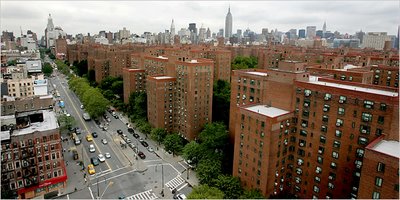By JANNY SCOTT
NYT, August 31, 2006
With rising housing costs squeezing middle-class New Yorkers and with the Bloomberg administration struggling to slow the loss of homes that people like teachers and nurses can afford, the news that Stuyvesant Town and Peter Cooper Village could be sold and turned eventually into luxury apartments illustrates vividly the uphill battle the administration and the city are facing.
Nearly three-quarters of the 11,200 apartments in the two complexes, which Metropolitan Life is offering for sale, currently fall under the state’s rent regulation system and rent for as little as half the open-market rate. But a new owner who pays the $4 billion to $5 billion that MetLife is said to want may have a powerful financial incentive to try to remove many or most of those units from the rent regulation system.
While state law would prevent a new owner from charging market-rate rents to existing residents as long as they remain in their current apartments, an owner could in many cases have the unit deregulated when the current tenants die or move. Over the next decade or so, the best-known bastion of middle-class housing in Manhattan could become largely unaffordable to the middle class.
“We’re losing more at one end than we’re gaining in affordable housing at the other end through the mayor’s plan,” said Victor Bach, a senior policy analyst for the Community Service Society, an organization that studies and tries to alleviate poverty in the city. “This just tips the balance even worse. It’s more difficult to make the argument that the efforts of the city in affordable housing, which deserve a lot of praise, are going to compensate for the market losses that occur through sales.”
Mayor Michael R. Bloomberg has vowed to create and preserve 165,000 units of low- and moderate-income housing by 2013; administration officials say they have produced more than 17,000 units in the last fiscal year alone.
But housing experts say thousands of other moderately priced apartments are disappearing from the rent regulation system and from state and city subsidy programs that had kept rents low.
The administration has worked to preserve low-priced apartments in older buildings whose owners received government subsidies in return for keeping rents low under programs like the state’s Mitchell-Lama program.
The administration has offered owners incentives to remain in those programs, with some success. But it has less leverage in a strictly private sale like that of Stuyvesant Town and Peter Cooper Village.
The city and state are not, however, powerless.
City officials said they would be willing to work with any buyers who are interested in keeping Stuyvesant Town and Peter Cooper Village affordable to the middle class, and could offer incentives. For example, they might help a buyer with getting financing for a co-op conversion plan under which current tenants at certain income levels could buy their apartments at a reduced price.
Emily A. Youssouf, president of the city’s Housing Development Corporation, which encourages private investment in low- and moderately priced housing through things like low-interest mortgages and the issuance of bonds, said her agency could, for example, use its reserves to make a loan to a buyer that would enable them in turn to offer the apartments to current residents at prices they could afford.
“From the seller’s perspective, they can get the same price,” Ms. Youssouf said. “As long as they can make as much money, I think that’s probably their primary concern. Remember, MetLife built these properties with help from the city. Do they have any obligation to do something like this? I think the answer is no. But as long as they can still make a good return on it, why would they not want to do it?”
Two years ago, the city helped persuade the owner of West Village Houses, a 420-unit apartment complex that had become eligible to leave the Mitchell-Lama program and begin charging market-rate rents, to convert the complex to a co-op and sell the apartments to the tenants at a discount rate. As part of the agreement, the administration agreed to forgive $19 million of interest accrued on a city mortgage loan and to recommend a tax exemption for 12 years.
Earlier this year, the tenants of two large working-class apartment complexes, Lafayette-Morrison and Lafayette-Boynton, near Soundview Park in the Bronx, said they had arranged for a group of real estate investors to buy the buildings and sell the units to tenants. In that case, the city extended the existing real estate tax abatement on the buildings to help make the deal possible and keep the price of the units low.
In another case, the city helped arrange tax breaks and other incentives that enabled CPC Resources Inc., which develops moderately priced housing, to buy Parkchester, a 12,000-unit apartment complex in the Bronx also built by MetLife.
“Clearly, the potential sale of Stuyvesant Town and Peter Cooper Village is of significant concern to the administration and the mayor and we would very much want to work with any potential buyer to preserve affordable housing in these properties,” Shaun Donovan, commissioner of the Department of Housing Preservation and Development, said yesterday.
